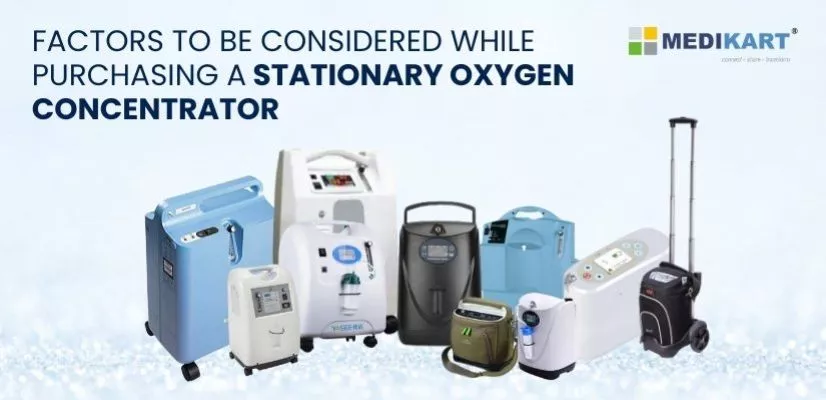An oxygen concentrator is a medical device that provides supplemental or extra oxygen to a patient with breathing issues. An oxygen concentrator works by filtering and concentrating oxygen molecules from the ambient air to provide patients with 90% to 95% pure oxygen. In today’s unpredictable time, this medical device is of utmost importance with the pandemic (COVID-19) just off of our heads. The demand for this product skyrocketed in the past 2 years and tons of new manufacturers emerged with this spike in demand.
Oxygen concentrators come in 2 different variants namely Portable oxygen concentrators (POC) and Stationary/Home oxygen concentrators, today we’ll focus on the latter and discuss what factors should be considered while purchasing a stationary oxygen concentrator:
- Flow Rate
The flow rate capabilities are easily one of the most significant elements to consider when selecting an oxygen concentrator. The rate at which oxygen may move from the machine to the patient is referred to as flow rate.
A doctor will usually recommend the best flow rate for a patient, so talk to your doctor about any potential oxygen concentrator purchases before making them.
Certain oxygen concentrators may have lower flow rates (between 250 and 750 mL/min), while others may have higher flow rates (such as the 2 to 10 liters per minute range). Because not all oxygen concentrators provide the same range of flow rates, it is crucial that customers review the flow rate offered by a product before making a purchase.
- Power consumption
An oxygen concentrator’s wattage is determined by its size and the settings you use. It will not run on batteries if you want to use a stationary oxygen concentrator. They are designed for people who require more oxygen and are therefore larger and heavier. You may predict how much your electricity bill will rise by looking at the amps and volts specs on the product packaging.
You can use a concentrator that runs on batteries if your oxygen needs are low and consistent. These are also lighter and more portable. These concentrators have a battery backup to ensure that your safety is not jeopardized when you need them.
- Oxygen concentration
Oxygen concentrators filter the surrounding air and supply oxygenated air with a predetermined percentage of oxygen to the user. This is what is known as oxygen concentration.. Every concentrator type has a variable oxygen concentration capacity depending on the design, quality, and quantity of filtration systems.
The oxygen therapy device levels are usually between 87 and 99 percent, which is the same as the oxygen concentration in an oxygen cylinder. Patients with chronic respiratory difficulties require the highest oxygen concentration possible to breathe. They must choose high-powered choices that can deliver large amounts of oxygen.
People who do not require high oxygen therapy devices, on the other hand, can use portable and lightweight oxygen therapy devices.
- Portability
When looking for oxygen therapy devices, one of the first and most significant things to consider is how mobile you’ll need your therapy devices to be. The size and portability of oxygen therapy devices can vary greatly.
High-powered units work hard and deliver higher flow rates, but manufacturers often design them to be larger and heavier. These versions typically produce larger flow rates, making them ideal for home usage.
There are a variety of portable oxygen therapy devices on the market. These portable oxygen therapy devices, which typically weigh 5 to 10 pounds, forgo higher flow rates in order to be substantially easier to transport and use while out and about. This makes them ideal for those who do not demand high oxygen flow rates.
- Brand
Only buy from well-known brands. Oxygen therapy devices are available throughout the country from a variety of brands and sites. Not all of them guarantee high quality. Medikart, Philips, and a few US-based brands are the most popular in India. The therapy devices made in China don’t provide the kind of quality and performance that a Covid-19 sufferer requires.
- Capacity
The oxygen concentrator’s capacity must be greater than your requirement. For example, If you need a 3.5 LPM oxygen machine, you should get a 5 LPM oxygen machine. In the same way, if you need a 5 LPM oxygen machine, you should get an 8 LPM machine.
- Price
There are numerous online and offline sellers of respiratory care goods, and big discounts are frequently available. Before you go out and buy an oxygen machine, you should have a rough sense of how much each variety costs.
- The price of a 5 LPM Home oxygen machine normally ranges from 40,000 to 75,000. Some local and China imports may be less expensive.
- The cost of a high-flow (8-10 LPM) Home oxygen machine ranges from 70,000 to 1,20,000 dollars.
- Warranty
Manufacturers offer a warranty for oxygen machines, and reviewing the policy is crucial. Ensure you know precisely what you’re purchasing as these devices run for extended periods.
Some oxygen machines have extra features that can make them easier to use and more effective. These may include carrying cases, flow-locking settings, easy-to-replace filters, and attachments. It’s important to research the available options before buying an oxygen machine. Keep these factors in mind when purchasing stationary oxygen therapy to make an informed decision.
Disclaimer
The information provided is for general knowledge only. Consult your doctor for personalized advice and treatment. Medikart HealthCare is not liable for any actions taken based on this info.

